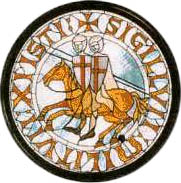
- Image via Wikipedia
I’m changing things up a little and providing a very brief review of an audiobook I just finished called “The Templars: Knights of Christ.” The goal of the author, Regine Pernoud, was to separate the fact from fiction regarding these monk warriors. They are often depicted as mysterious, magical, and secretive in movies like “The Divinci Code”, “National Treasure“, or “Kingdom of Heaven” and always having an ulterior motive behind everything they do. Several movies and books depict them as being involved in cover ups, plots to overthrow kings, and other wild conspiracies. However, the facts of this ancient order are more mundane. They mainly protected Christian pilgrims to the Holy Land and guarded treasures for royalty and banks. Unfortunately for the book, going through these facts was equally mundane and left me longing for a little Hollywood-style embellishment.
In order to dispel the myths of the Templars, the book goes into great detail about their charter, rules, daily life, war campaigns, and forts and dwellings. It cites many original documents to ensure accuracy. Unfortunately, the book covers everything in so much detail that I started to “zone out” during sections of the first few chapters. It is very difficult to stay engaged and interested as the book goes on for several minutes listing the Templar’s military campaigns in the Middle East or describing their clothing regulations in a checklist-like style fashion. Instead of these details providing a complete overall picture of the Templars, they become distracting as the book dives deep into the minutia of their lives. The book gets mildly more interesting towards the end as it covers the Templar’s accusations, trials and eventual breakup. But even that section comes across very dry and drawn out as it cites court documents and statements from the period.
Unfortunately, “The Templars: Knights of Christ” comes up short on addressing the myths and falsehoods of the order. I really wish the book actually addressed how certain movies and books depict Templars and then explain the historical inaccuracies of those premises. Instead it just assumes that the reader (or listener in my case) will already know about how the Templars are depicted in popular culture and immediately jumps into citing historical documents. Possibly the book makes a better reading experience than listening experience. In short, I found this audiobook only mildly interesting so I can only mildly recommend it. Hopefully my next book (G.K. Chesterson’s “Orthodoxy”) will prove more interesting.

